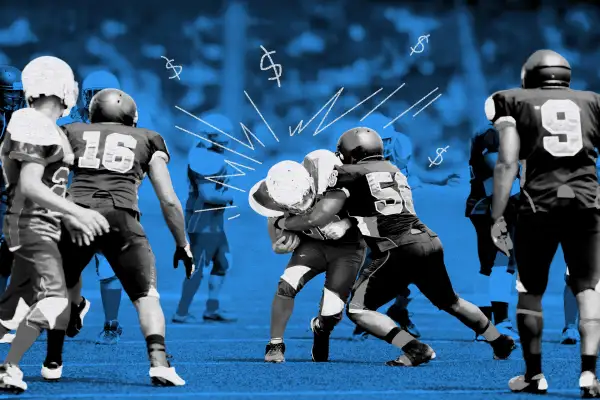Former College Athletes Can Now Submit Claims for Payouts in $2.8 Billion NCAA Settlement

Thousands of college athletes can now submit claims for part of a multi-billion dollar settlement aimed at paying athletes a share of the revenue colleges made on their performances.
The proposed $2.8 billion settlement stems from a landmark case involving allegations that many current and former athletes were wrongfully denied compensation for the use of their name, image and likeness (NIL).
Historically, college athletes haven't been allowed to receive compensation aside from scholarships and payment for limited expenses. That all changed in 2021, when new rules and state laws allowed athletes to earn money for commercial use of their image through brand deals and agreements with school-specific collectives funded by fans and alumni.
This settlement, which resolves several lawsuits against the NCAA and major athletic conferences, could further upend the college sports landscape, and ultimately lead to colleges paying athletes directly.
Athletes who played from 2016 onward are covered in the settlement. The biggest payouts from the $2.8 billion-fund will likely go to football players, and the largest individual amount could be as high as $1.85 million.
Among the athletes poised to receive big checks if the settlement goes through, some have gone on — or will go on — to high-earning careers in the NFL and the NBA, but many others have not. For that latter group of athletes who haven't made much if anything from their athletic careers, the payouts could be life altering, according to lawyers in the case.
The agreement still has legal hurdles to clear, but a judge granted preliminary approval last week opening the door for the claims process to begin. The settlement website is now live and those who are eligible will begin receiving notifications Friday.
This matter is most commonly referred to as the House v. NCAA settlement, but the settlement would also resolve two other antitrust cases.
Breaking down who gets paid from the settlement
There are three key groups of athletes defined in the agreement: Power Five men's football and basketball players, Power Five women's basketball players and all other Division I athletes. (Power Five refers to the then most prominent NCAA conferences: the Atlantic Coast, Big Ten, Big 12 and Southeastern, as well as the now much-smaller Pac-12.)
Based on estimates provided by attorneys for the plaintiffs, the average payouts will be $135,000 for those men’s football and basketball players and $35,000 for the women’s basketball players. Other athletes would be eligible for smaller payouts ranging from hundreds to thousands of dollars, or in some cases even less. Over 400,000 athletes are potentially eligible to make claims.
Why are these three sports — and football, in particular — so favored? According to a court filing, sports outside of basketball and football add "little or no value to the conferences' media contracts," and for that reason, other athletes are not entitled to a share of the largest portion of the settlement connected to broadcast media, which the Power 5 basketball and football players were allegedly wrongfully denied.
Jim Cavale, chairman of Athletes.org, a players association, says someone like Saquon Barkley, who played football at Pennsylvania State University and is now the star running back for the Philadelphia Eagles, will likely get a sizable payout since he was a workhorse back in a high-revenue program. (He probably won't be the highest paid, however, as Money’s review of the proposed settlement formula indicates that slightly younger players at more valuable positions like quarterback could benefit even more.) On the other end, some Olympic sport athletes would only get a few hundred bucks, Cavale says.
Exact payouts — which are based on a formula developed by University of San Francisco professor Daniel Rascher, an expert in the economics of college sports —would depend on the school attended, with athletes who played on teams at colleges that brought in higher revenues resulting in a bigger check. The amount athletes played or competed also counts. For football, that’s measured in snaps. In basketball, it’s based on minutes.
For Power Five football players, part of the money would be paid out based on the value of players' respective positions (with typical NFL player pay used to measure this), which is why quarterbacks will likely get more from the settlement than running backs. In basketball, performance statistics measuring how many extra wins a player generated for their team factor into the equations.
Another part of the formula determines how much athletes should get for missed video game opportunities, but this is a relatively small piece of the overall pie.
What is the timeline for athletes to get paid?
Individual athletes won’t know the amount they’re eligible to receive from the settlement until at least December, according to attorney Luke Fedlam, partner and head of sports law at Porter Wright in Columbus, Ohio. Any payments would be paid out annually over a period of up to 10 years.
Fedlam, who is not an attorney in the case, also stressed that this settlement is still in a preliminary stage, and athletes will have the chance to opt out of the settlement to preserve their rights to pursue their own litigation against the NCAA or the five major conferences that are named defendants.
A final approval hearing is scheduled for April 7, but even if it is approved, there will likely be appeals. "The question here is going to be, what is going to be done to ensure that student athletes receive what they deserve out of this settlement?" Fedlam says.
Fedlam says there's already a group looking to appeal due to questions around Title IX, which is the federal law that mandates equal treatment for male and female athletics on camps. Some student athletes are surely going to think that they were worth more and should receive more, which could lead to appeals and opt outs. "There's still a long way to go," he says.
While there's still an appeals process that needs to be worked out, many in the sports world are celebrating the historic nature of the settlement.
What else does the settlement do?
The $2.8 billion pot of money is intended to pay retroactively for alleged damages from missing out on television and marketing rights. But a separate — and potentially more significant — part of the settlement creates a roadmap for the future of compensation in college sports through revenue sharing.
Under the model, many colleges would be able to spend up to $22 million annually on athlete pay, and they could allocate that money however they see fit. As soon as next summer, Cavale says about 70 schools could be using that max budget, dramatically changing the landscape of college athletics. Over the next 10 years, college athletes could earn between $15 billion and $20 billion through revenue sharing.
The deals athletes are earning now through third-party agreements? That would be the "icing on the cake," he says.
More from Money:
Facebook Settlement Payments Won't Go Out Until Early 2025 (or Later)
Don't Make This Costly 401(k) Mistake When Switching Jobs
The Key to Getting a Salary Bump Next Year? Returning to the Office





